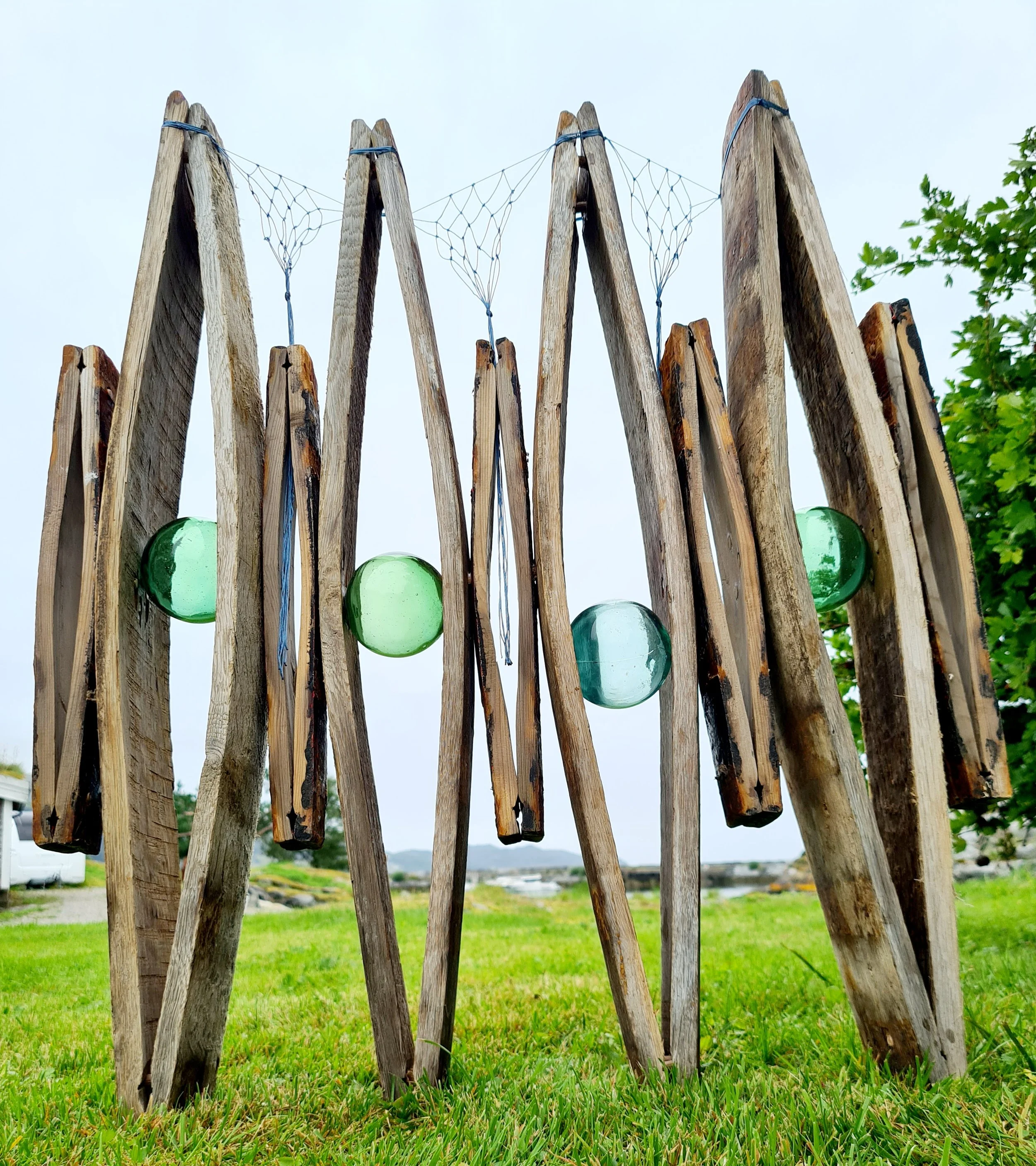Barrel affordance





In this blog article I investigate affordance in a sculpture I created from old fishing tools. I base my reflections mainly on Katherine Leducs text Art as Affordance (Leduc, 2013), but also on articles from the no. 7 issue of Art Style, Art & Culture International Magazine (Wagner et al., 2021), an issue focusing on Affordances as a complementory method in Visual Culture Studies.
The barrel
At a family clean up of an old boat house I found some old barrel material. The curved planks bore traces of old, worn paint, sea washed wood and rusty nails, but were no longer the thing, the barrel that i could relate it to, just loose planks in a pile. I was attracted to the beautiful curves, all the same curve, once intentionally manipulated, then assembled to hold fish or other fishing tools. With the gaze of an artist, these planks offered formal possibilities for creative work, as explained below:
“The concept of affordances roots in the studies of the American psychologist James J. Gibson, […]. According to him, “things” naturally inhere affordances. They offer a certain range of possible activities depending on their form, time patterns, and material qualities, thus becoming part of human-thing-interactions (Wagner et al., 2021, p.8).
Ian Hutchby describes it as “The possibilities that they (objects) offer for action” (Hutchby, 2001)
I was attracted to the tradition, culture and history this material held. Playing with the forms geometric qualities, I played with repetitions and patterns, containing the old, yet shaping something new. In this play, new spaces appeared.
The space in between the barrel planks, put together in a new and not useful way, created a tension that could hold something there, without any fixatives. Being “negative”, that is not a physical object, but a creation of objects surrounding it, this being of air, to me it suggested a frame that could hold something of a light, transparent quality, and a thought of green glass spheres used int eh old fishing industry appeared. These were typically used with fish nets to keep them stretched and floating. These are therefore a familiar representation of the old fish industry, dominating this area by the coast for the previous generation. Today they are often used to decorate cabins and boat houses, becoming a familiar and sentimental representation for these types of spaces, and i will argue they have come to represent slightly kitsch but cosy decoration.
Old fish net glass sphere
In this way, the artwork re-uses this once intentional bending of the wood for a display purpose. The negative space that appears becomes an image of the original intention, an intentional energy once upon a time added to the material for a useful purpose, today only used for decoration to suggest “fishing culture” or “the good old days”. In this way I try to play with affordances, based on the different times the materials represent.
The fish nets
Text coming about the fish net elements. Craft, skills, usefulness.
These affordances where not explicitly reflected upon as the sculpture idea emerged. Post reflection, the affordance becomes apparent, from material qualities, cultural context and myself as an artist, with agency to reshape.
I did not know if this sculpture was a good idea, nor quite what it held, but i wanted to use it to cultivate what i call “sitting muscle”: “Sitzen fleisch”. This is an expression my German friend Sandra taught me. I learnt it, she said, when i was writing my PHD. “I had to stick with it, after my curiosity had been used up, I had to stick with it and see it through”. My wish to cultivate “sitzen fleish” in my creative work, thus became an important agent for re-framing these old objects of an old trade, into something holding an artistic quality.
Sources
Leduc, K. (2013). Art as Affordance. The University of Western Ontario Journal of Anthropology, 21(1). https://doi.org/10.5206/uwoja.v21i1.8937
Christiane Wagner, Elisabeth Günther, Martina Sauer, Petra Leutner, Klaus Schwarzfischer, Stefanie Bräuer, Fabiana Senkpiel, Sarah Ullrich, Katharina Geis, Hans Dieter Huber, Yael Young, Nikolaus Dietrich, Sven Günther. (2021). Art Style, Art & Culture International Magazine, no. 7. https://doi.org/10.5281/zenodo.4593303
Hutchby, Ian. 2001. Conversation and Technology: From the Telephone to the Internet. Cambridge, UK: Blackwell Publishing.







